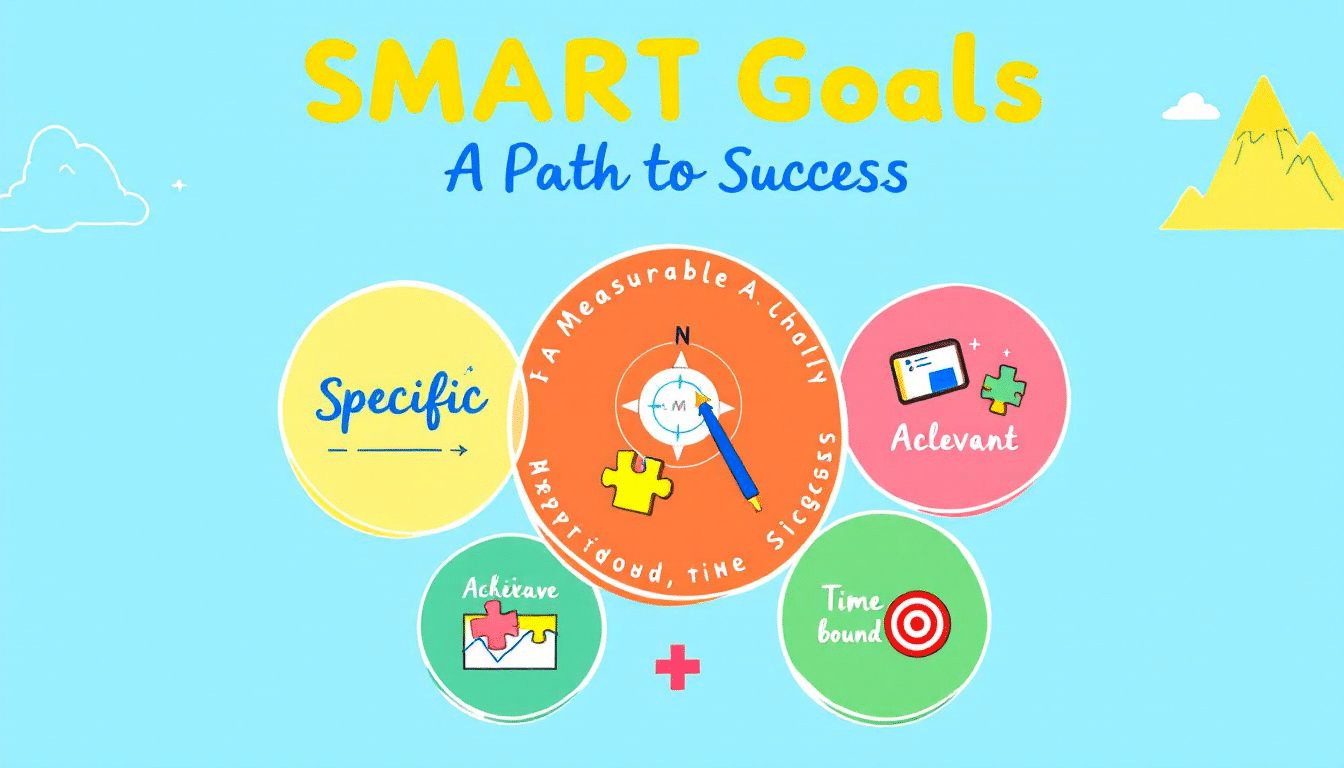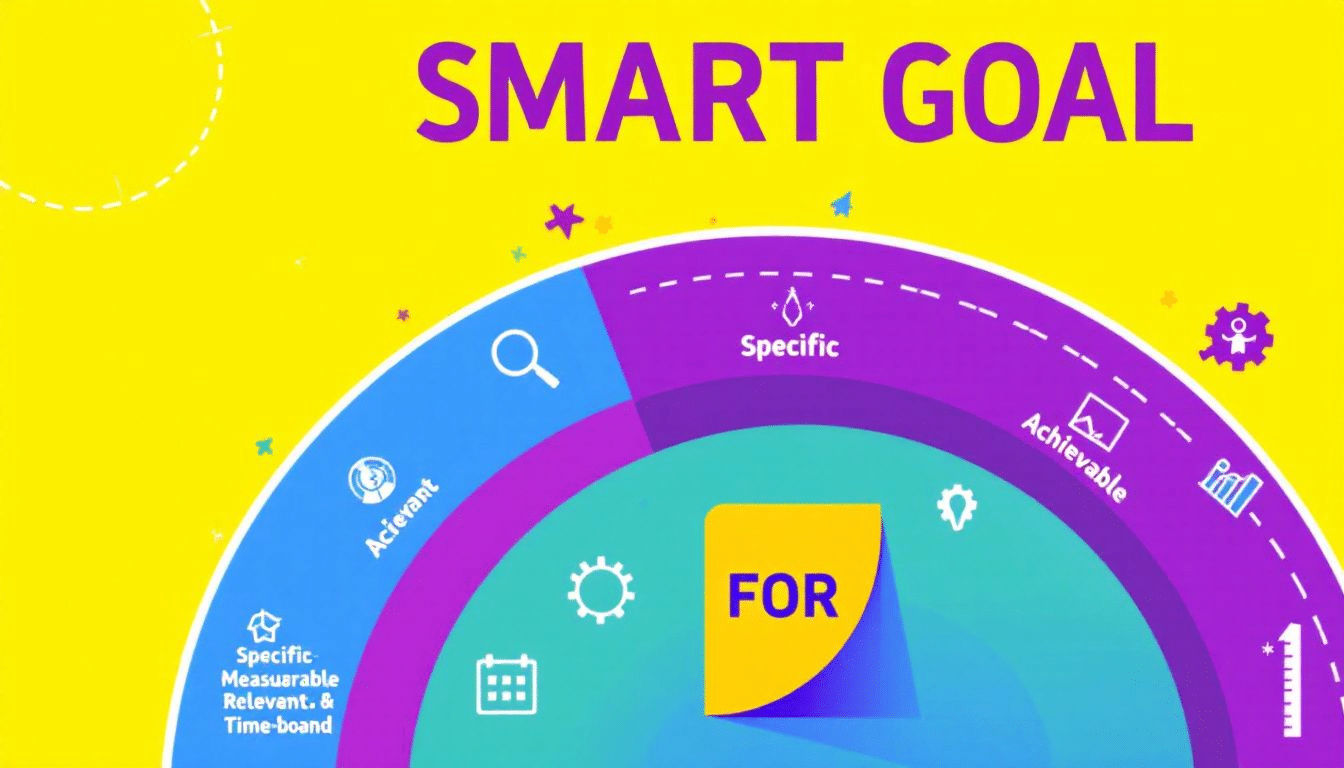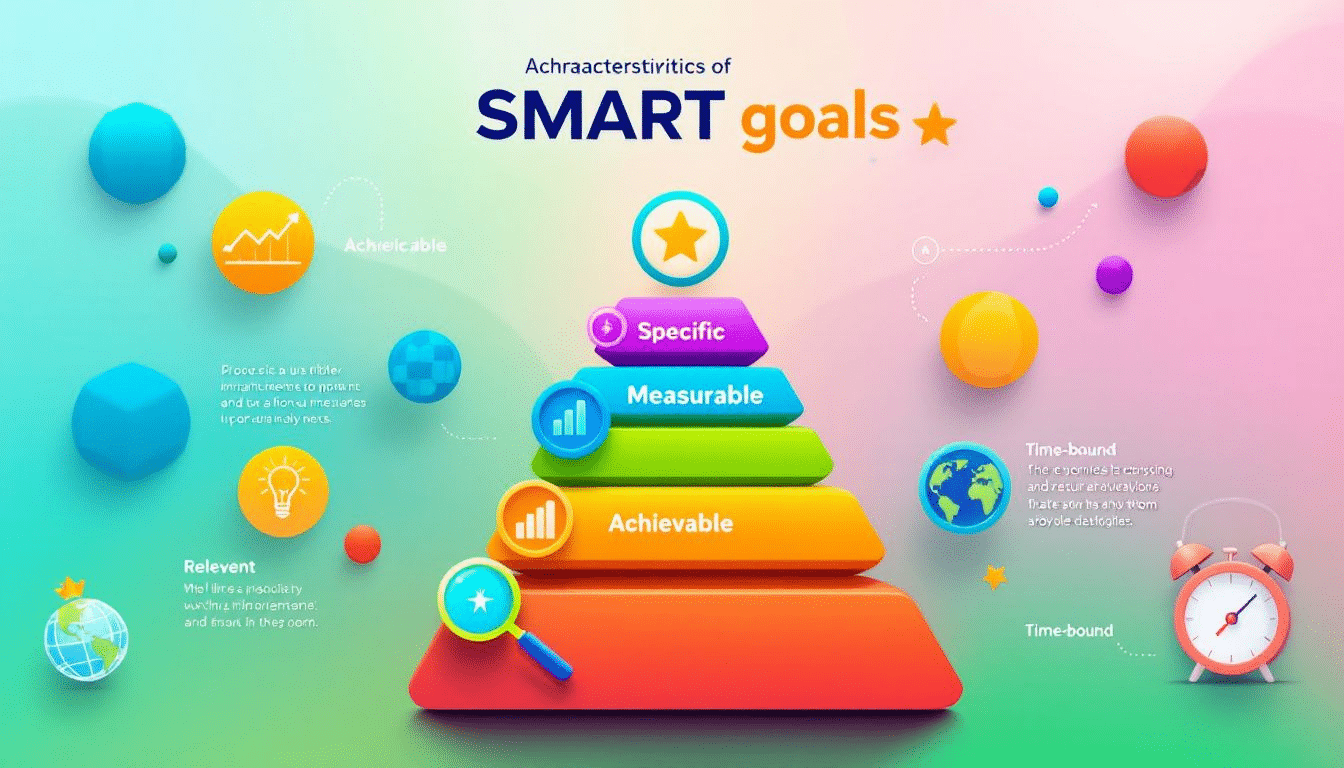Wondering what are characteristics of SMART goals? SMART goals stand for Specific, Measurable, Achievable, Relevant, and Time-bound. Understanding these qualities helps you create clear, actionable, and effective goals.
Key Takeaways
SMART goals provide a clear and structured framework, focusing on Specific, Measurable, Achievable, Relevant, and Time-Bound objectives.
Establishing measurable targets and timelines enhances motivation and accountability, making it easier to track progress and achieve goals.
Aligning personal aspirations with professional objectives ensures commitment, fostering a sense of responsibility and driving success.
Understanding SMART Goals

SMART goals are clearly defined objectives that enhance focus and motivation. A smart acronym represents five key criteria. These are Specific, Measurable, Achievable, Relevant, and Time-Bound. This structured approach to goal setting helps create a roadmap for specific targets, making it easier to achieve both personal and professional aspirations. But why are SMART goals so effective?
The purpose of setting a SMART goal is to create a clear pathway to success, removing ambiguity and ensuring that every step is planned, executable, and trackable. SMART goals enhance business strategy and personal growth by fostering focus, motivation, and shared purpose. Imagine having a set of goals that not only guide your actions but also keep you motivated and on track – that’s the power of SMART goals.
Setting SMART parameters makes objectives achievable within a timeframe and helps track progress. First introduced by Peter Drucker in 1981, the concept of SMART goals has stood the test of time and continues to be a cornerstone of effective goal setting in both personal and professional contexts. As you embark on the journey of goal setting, embracing the SMART framework can lead to remarkable achievements.
Specific Characteristics of SMART Goals

The first step in setting SMART goals is to ensure they are specific. Specificity in goal setting removes uncertainty and ensures clear expectations, which in turn helps focus efforts and resources effectively. Specific goals greatly increase the likelihood of accomplishment. This clarity provides a better focus for achieving desired outcomes and allows you to set smart goals while also emphasizing the importance of setting goals.
Vague goals, on the other hand, can leave you directionless and unmotivated. So, how can you make your goals specific?
Defining Specific Goals
Defining a goal accurately involves addressing the five ‘W’ questions comprehensively: What do I want to achieve? Why is this goal important? Who is involved? Where is it located? Which resources or limits are involved? For instance, a specific SMART goal could be aiming to become the head of marketing in your company. Another example could be a business-specific goal like growing the number of monthly users of Techfirm’s mobile app.
A realistic time frame is crucial for achieving smaller goals that lead to the final objective. Defining clear criteria enhances individual motivation and fosters a sense of responsibility.
Breaking down the goal into smaller, manageable tasks helps track progress and maintain motivation. Asking specific questions helps make your goal measurable and sets the stage for the next step in the SMART framework.
Examples of Specific Goals
Examples of specific goals can greatly illustrate the concept. In personal development, you might set a goal to learn a new skill by attending specific courses. If your aim is to improve your health, you could set a goal to lose one pound of body fat weekly.
In a business context, a specific goal might be to increase the number of monthly users by 1,000. These examples show how specificity can turn vague aspirations into concrete, actionable plans.
Measurable Characteristics of SMART Goals

Having measurable criteria eliminates ambiguity in goals, making it easier to track progress and meet deadlines. Measurable goals facilitate tracking progress and evaluating success, which is crucial for maintaining motivation. Without criteria for a SMART goal, you will not be able to determine your progress, leading to a lack of direction and focus.
Let’s explore how to establish measurable criteria and track progress effectively.
Establishing Measurable Criteria
Measurable criteria are crucial for tracking progress and determining success in goal setting. Setting quantifiable benchmarks sustains motivation as progress becomes visible over time. For instance, if your measurable goal is to increase monthly users by 1,000, you can track the number of new users each month to measure your progress.
Using metrics or milestones allows for clear quantification of goals, providing specific targets to aim for. Whether it’s sales figures, customer feedback scores, or project milestones, these metrics help keep your efforts focused and on track.
Establishing these criteria at the outset ensures that you have a clear roadmap to follow and can celebrate small victories along the way.
Tracking Progress with Measurable Goals
Incorporating measurable, trackable benchmarks into objectives significantly enhances their impact. Measurable criteria enable individuals and teams to monitor advancements effectively and make necessary adjustments. For example, in customer service, monitoring average call wait times can help track progress towards reducing these times.
Regularly reviewing these metrics keeps you on course to achieve your goals efficiently.
Achievable Characteristics of SMART Goals

Achievable SMART goals must be realistic and attainable; they should challenge but remain within reach. Setting achievable goals is important as they stretch abilities without being unattainable. A common mistake in goal setting is the lack of intrinsic motivation, often leading to unachievable goals.
Let’s look at how to assess achievability and see real-world examples of achievable goals.
Assessing Achievability
Evaluating a goal’s achievability involves examining both available resources and existing constraints. Communication about constraints and potential obstacles is crucial for safeguarding a goal’s achievability. Breaking larger goals into smaller, manageable objectives can help maintain achievability. For example, if your goal is to run a marathon, starting with smaller goals like running a 5K can help build up to the larger objective.
Goals that are overly ambitious can cause discouragement and lead to failure if they do not account for personal limitations or external conditions. Realistic targets that challenge but do not overwhelm help maintain motivation and a sense of accomplishment. Assessing achievability is about balancing ambition with practicality.
Real-world Examples of Achievable Goals
Real-world examples of achievable goals include increasing monthly users by 1,000 through app-store optimization and targeted social media campaigns. Scaling back objectives to more manageable targets can often reveal previously overlooked opportunities or resources.
These examples show how setting realistic, attainable goals can lead to success and uncover new possibilities.
Relevant Characteristics of SMART Goals
Goals that matter personally enhance commitment and engagement. When goals align with individual aspirations, they resonate more deeply on a personal level, significantly enhancing motivation. The relevance of SMART goals is tied to their ability to connect personal aspirations with larger objectives.
Let’s explore how to align goals with personal and professional objectives and look at examples of relevant goals.
Aligning Goals with Personal and Professional Objectives
SMART goals should be designed to reflect both individual ambitions and the overarching mission of the organization. Setting SMART goals fosters a sense of accountability that encourages individuals to stay committed to their objectives. For example, if your personal goal is to develop leadership skills, aligning this with your professional objective to lead a team project can enhance your motivation and commitment.
Support from others is crucial to maintaining accountability when pursuing relevant goals. Retention of responsibility while seeking support is important for achieving relevant goals. Aligning goals with personal and professional objectives creates a synergistic effect that propels you forward.
Examples of Relevant Goals
Examples of relevant goals include growing the number of monthly users of Techfirm’s mobile app by 1,000, and investing in new customer service employees to decrease wait times. These goals drive everyone forward while ensuring individual responsibility, and they contribute to broader objectives like generating more conversions.
Relevant goals help align individual efforts with overarching plans for success.
Time-Bound Characteristics of SMART Goals
Incorporating timelines into SMART goals ensures that everyone involved understands when the objectives should be accomplished. A defined timeframe instills a sense of urgency and responsibility in achieving goals. Deadlines create urgency and prioritize tasks, enhancing focus in goal setting.
Let’s discuss how to set deadlines and the impact of time-bound goals.
Setting Deadlines
Setting deadlines creates a sense of urgency and helps prioritize tasks. For example, achieving the goal of becoming the head of marketing typically takes about five years. Establishing realistic timelines enhances the likelihood of completing goals successfully. Realistic timelines not only guide the process but also keep individuals motivated and accountable.
Clear deadlines enable the creation of a structured plan outlining the steps to achieve your goals. This helps break down larger tasks into manageable chunks, making the overall goal seem less daunting. Moreover, having a target date keeps you focused and driven, ensuring that you stay on track and make consistent progress.
The Impact of Time-Bound Goals
Time-bound goals are crucial as they create urgency and help prioritize tasks, thereby maintaining focus and momentum. For instance, setting a goal to lose four pounds of fat by the end of August provides a clear timeline and encourages consistent effort towards goal achievement.
Deadlines enhance motivation by providing a clear timeline and encouraging consistent effort towards goal achievement. Overall, time-bound goals are effective in driving individuals towards their objectives by instilling a sense of urgency and accountability.
Benefits of SMART Goals

SMART goals provide clarity and direction for efforts, ensuring individuals stay focused on their objectives. The SMART framework enhances motivation by making goals relevant and significant to both personal and professional aspirations. The strategic framework of SMART goals helps maintain focus and organization, aiding efficient attainment of objectives.
Let’s explore how SMART goals offer clarity, direction, and enhanced motivation and accountability.
Clarity and Direction
The SMART framework provides a structured approach that clarifies the path to achieving objectives. SMART goals clarify objectives, allowing individuals to concentrate their efforts effectively. The structured nature of SMART goals helps ensure that efforts are systematically aligned with defining objectives. This clarity and direction are crucial for maintaining focus and ensuring that resources are used efficiently.
Clear, specific goals help avoid the pitfalls of vague and ambiguous objectives. This not only helps you stay on track but also allows you to measure your progress and make necessary adjustments along the way.
In a business context, clear goals ensure that all team members are on the same page and working towards a common objective, leading to better coordination and higher productivity.
Enhanced Motivation and Accountability
Measurable goals assist in maintaining your focus and meeting deadlines. They also generate excitement as you approach your goal. Specific timeframes motivate teams to implement improvement strategies. Deadlines can enhance team motivation by encouraging the implementation of improvement strategies.
Setting SMART goals ensures that everyone remains accountable, driving both individual and collective efforts towards achieving the desired outcomes.
Common Pitfalls and Solutions in SMART Goal Setting
Employing the SMART framework enhances the likelihood of achieving both personal and professional goals. However, common pitfalls such as lack of accountability, quitting too soon, and setting arbitrary deadlines can hinder progress.
To ensure relevance and adapt to changing circumstances, it’s crucial to address these pitfalls head-on. Let’s explore how to avoid overly ambitious goals and maintain flexibility in goal setting.
Avoiding Overly Ambitious Goals
Communicating any restraints and potential roadblocks upfront is essential to safeguard the achievability of a goal. For example, a goal like “Get that promotion!” may be influenced by factors outside of individual control, making it overly ambitious. Setting realistic and attainable goals is crucial for maintaining motivation and a sense of accomplishment.
Evaluating resources, constraints, and limitations allows for setting achievable stretch goals that challenge your abilities. This realistic approach not only prevents discouragement but also fosters a sense of progress and achievement.
Breaking larger goals into smaller, more manageable tasks can further ensure that they remain attainable and motivating.
Maintaining Flexibility
Maintaining flexibility in goal setting allows for adaptation to changing circumstances and priorities. Common pitfalls in goal setting can hinder progress, making it essential to adapt goals as situations evolve. Setting realistic targets that consider current resources and constraints helps avoid overly ambitious goals.
Flexibility in goal setting not only enhances the likelihood of success but also fosters resilience in the face of challenges.
Summary
In summary, SMART goals are a powerful tool for effective goal setting, providing clarity, direction, and enhanced motivation. By ensuring your goals are Specific, Measurable, Achievable, Relevant, and Time-Bound, you can turn your aspirations into actionable plans. Embracing the SMART framework can lead to remarkable achievements in both personal and professional contexts. Get started today and watch your dreams turn into reality!
FAQ
What does the SMART acronym stand for?
Utilizing the SMART framework—Specific, Measurable, Achievable, Relevant, and Time-Bound—can dramatically enhance your goal-setting process. Embrace this method to create clear and motivating objectives!
How can I make my goals more specific?
Make your goals more specific by clearly answering the five ‘W’ questions: What do you want to achieve, Why is it important, Who is involved, Where will it take place, and Which resources will you use? Embrace this clarity, and you’ll be on your way to achieving your dreams!
Why is it important to have measurable goals?
Having measurable goals is crucial because they provide clarity, allowing you to track your progress easily and stay motivated along the way. Set specific targets, and you’ll see just how far you can go!
What are some examples of achievable goals?
Achievable goals could be increasing monthly users by 1,000 through targeted promotions or committing to run a 5K as preparation for a marathon. Setting these specific targets can motivate you to reach your larger aspirations!
How do time-bound goals improve motivation?
Time-bound goals significantly boost motivation by instilling a sense of urgency and prioritization, keeping your focus sharp and your momentum strong. Embrace deadlines to propel yourself towards success!





